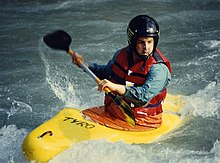Canoe helmet

A canoe helmet is a sports helmet for canoeists designed to prevent or alleviate skull injuries to the canoeist. The main risk of injury is from rocks (over water or after capsizing under water, especially in shallow rivers) and to a lesser extent from colliding with other paddlers or objects. To a lesser extent, a canoe helmet can also help against grazing branches, cold, sunstroke or drowning (see below).
The canoe helmet is worn when whitewater paddling , canoe polo and sea kayaking while driving in the surf or on rocks. It also protects against low branches on small rivers or a paddle when playing canoeing.
Canoe helmets must pass a test in accordance with EN 1385. For example, the date of manufacture must be indicated so that a helmet with material fatigue is not used. If you hit the helmet, it should be changed anyway, even if no external damage can be seen with the naked eye.
In addition to impact resistance, a firm fit is crucial because, in addition to unprotected areas, incorrect pulling on the chin strap can lead to injuries. The helmet should reach on the forehead to the eyebrows and firmly back to the neck. He shouldn't move too much due to pressure and nothing should slip into the neck. Canoe helmets are available in fixed sizes and adjustable with different fittings or neck straps. The latter are particularly beneficial for canoe rentals , schools and clubs . But even if you want to drive with or without a neoprene hood, the variability is advantageous. To find the canoeist again, the color of the helmet is important.
Helmets differ in how much they surround the head. There is the full cut helmet that covers the entire head and is also equipped with a protective grille , similar to a facemask , for canoe polo . There are also helmets with a chin guard. With all-round protection, however, communication, field of vision and breathing can be impaired. If the risk is lower, half cut , side cut or half-shell helmets are also worn. These can also have additional ear cups.
Opinions on helmets that have a protruding peak similar to a peaked cap are controversial . Some whitewater paddlers hope that they will create a small cushion of air in front of their face under the flowing water on a helmet that has no air holes on the surface of the head; if a paddler is stuck on a rock, for example, the current should run over the paddler's head and the helmet screen, but not directly into the face and thus into the airways. The umbrella also protects the paddler's forehead deeper into the face than an umbrella-less helmet that ends above the eyebrows. A protrusion on forehead and temples can also serve as an additional crumple zone in the event of a collision. Finally, the umbrella can provide protection from the sun and splash water (especially when the head is lowered, when driving through waves), as can the soft umbrella of a baseball cap worn under the helmet or a fabric umbrella that can be attached to a canoe helmet . On the other hand, pulling a screen in the event of a fall can reduce the protective effect of the helmet.

